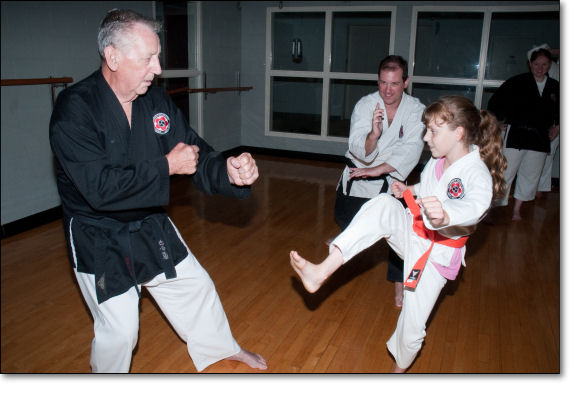Meaning of the Seirenkai Logo
In addition to the kanji for Seirenkai (Association of Integrity), the logo or graphic representation of the International Seirenkai Organization (ISO) is shown above. All Seirenkai members can benefit from understanding the meaning and symbolism of the logo. It offers many important lessons about the Seirenkai style and its roots in the traditions and historic cultures of East Asian martial arts. Some of these lessons relate to martial arts history while others are indicators of the organizational culture and emphasis of the ISO today.
- The round outer shape of the logo reflects continuous development:
- no ending to one's training
- no ending to the ability to be part of the organization
- no ending to the growth and maturation of the ISO
-
The red, five-petal flower in the center is a traditional Japanese mon (family crest) and reflects the country of origin for Jujitsu and the Bushido roots of our two martial arts. This famous mon is called Ume, or Plum Blossom. Its significance in Japanese literature is that it represents the season of Spring. In many cultures, Spring is considered "the beginning," an equally important principle in Seirenkai martial arts. New beginnings have both long term and daily relevance for Seirenkai members. Each training session is a new beginning and should be approached with shoshin (beginner's mind). The further students advance in their training, the more critical it is to return to the dojo on a regular basis with fresh eyes and spirit to revisit all previous lessons as well as learn new techniques.
Another important reason for the choice of this specific crest with five equal parts is that it represents Go-Dai, the Five Great Elements of the Universe:- Earth represents things that are solid.
- Water represents things that are liquid.
- Fire represents things that destroy.
- Wind/Air represents things that move.
- Void represents things not of our everyday life today, especially our roots and lessons of past masters.
These elements are all central pillars of traditional Jujitsu, reflected in the Itsutsu no Kata or "Forms of Five" and also the Koshiki no Kata or "Antique Forms." These concepts permeate many Jujitsu ryu-ha, and were specifically a direct influence on Dr. Jigoro Kano's initial conceptualization of Judo. They may be mapped to virtually every Seirenkai Jujitsu technique, and especially our throwing techniques. When considering the dynamics of an individual Jujitsu technique, one may contemplate how to maximize its accuracy and effectiveness by determining whether the execution of the technique should be rooted, flowing, evasive or destructive. For example, the lock and power of a strong karate stance may be appropriate when executing a takedown (earth) while the opposite is true if one were to execute a Jujitsu osoto-gari (water). Both techniques are powerful and correct, but the feel and dynamic character of each is quite different. - Tomoe- the center of the logo is the Tomoe, another traditional Mon that is especially representative of Okinawa, the birthplace and primary source of karate. The tomoe in its many different forms reflects balance, flow and continuity. This specific version of the Tomoe reflects three moving parts in balance with each other. For karate, this symbol captures the essence of the sanchin concept which is the inter-relationship between mind, body and spirit. For Seirenkai specifically, it reflects the three arts within this system: Karate, Jujitsu and Kobudo.
- The writing on the outer perimeter is self-explanatory, providing the name of the organization and its two primary martial arts. The language is captured between two solid circles, protecting the integrity (seiren) of the arts and the organization. The English name of the entity is called International Seirenkai Organization and its Japanese name is Kokusai Seirenkai Kyokai. The word Karate is now as commonly recognized in almost all nations globally as it is in Japan, and it means "Empty Hand." The word Jujitsu means "Gentle Art" or "Flexible Art." In martial arts terms, "gentle" implies the act of yielding or adapting, as opposed to directly confronting an attacking force with one's own force. It is the redirection and use of an opponent's energy that is "ju." Ironically, for the average observer, the art of traditional Jujitsu is anything but gentle.
The three colors of the logo are white, black and red. These colors reflect the three primary levels of members (present and future) within the organization and the three levels of the arts themselves.
- White is the beginning of the martial arts journey, understanding the basics, and it embodies all of the kyu ranks for mudansha (students below black belt).
- Black represents the Shodan rank, the true beginning of one's training after students have developed a solid martial arts foundation. The remainder of the yudansha, or black belt ranks (in this instance through hachidan - 8th Dan) are also included in this category.
- Red reflects mastery for the most senior of masters at the 9th Dan and 10th Dan levels. This level may eventually be achieved by a small number of meijin (experts or top level masters). More significantly, the representation of this level in the Seirenkai logo carries with it the memory and deepest respect for all the masters from the generations passed who have helped bring us to our training today, especially our own immediate teachers.



